
The Basilica of Santa Maria della Quercia is a Renaissance-style, Roman Catholic sanctuary church and minor basilica, about two kilometer outside of the center of Viterbo, on the road to Bagnaia, in the Region of Lazio, Italy.

The Basilica of Santa Maria della Quercia is a Renaissance-style, Roman Catholic sanctuary church and minor basilica, about two kilometer outside of the center of Viterbo, on the road to Bagnaia, in the Region of Lazio, Italy.
In 1417, a local artist painted an icon of the Virgin following the design of a local painter Maestro Martello. The image was placed on an oak tree in the countryside, and became a source of veneration, which only increased in 1467 during a scourge of the plague. Miracles were attributed to the icon, and the image was ensconced in a chapel. [1]
An altar was erected in 1467 and a chapel commissioned by Pope Paul II. [2] The chapel was initially affiliated with the Gesuati order, a Tuscan order which specialized in the aid to pilgrims. Within a few years, Franciscan monks substituted the priests of the Gesuati order and commissioned this larger church, built between 1470 and 1525. On the 8 of April 1578, the church was consecrated by the Cardinal Francesco de Gambara, who is buried in the church. The event was celebrated with a cycle of frescoes at the Palazzo dei Priori, Viterbo. The sanctuary acquired many patrons, including popes.
The facade is built with rustic stone. The three portal lunettes have terracotta decorations depicting the Madonna, Saints and Angels (1504–1508), completed by Andrea della Robbia. The bell tower has three orders of columns. The interior has a central nave and two aisles with a ceiling designed by Antonio da Sangallo the younger, depicting the symbols of the Madonna, Pope Paul III, and the Lion symbol of Viterbo. The Campanile, built in 1481–1505 by Ambrogio da Milano, was demolished in the 17th century. [3] [4]
The counter-facade has a fresco (1636) depicting the Miracle of the Priest of Canapina by Angelo Pucciati. The walls of the chapels have 17th and 18th-century frescoes detached from nearby suppressed or destroyed churches. In the presbytery is a small tempietto structure (1490) by Andrea Bregno, surrounding paintings were completed Michele Tosini, nephew of Domenico Ghirlandaio.
The apse has intarsia in the wooden choir stalls, and there is a tondo in the vault displaying a Madonna della Quercia (1519) by il Truffetta. The main altarpiece in the choir depicts the Coronation of the Virgin completed by Mariotto Albertinelli.
Left of the nave is a small room with ex-votos, including silver plaques and paintings from the 15th through 18th centuries depicting miracles attributed to the Madonna della Quercia. [5] [6] It also contains a 15th-century bust of Christ by Matteo Cividale, precious coral decorations from the 16th century.
The convent of Santa Maria della Quercia has two cloisters: one built in 1550–1663; the other choir, known as il Grande o della Fontana, has a Renaissance layout with 17th-century frescoed lunettes depicting the Miracles of the Madonna. [7]
The church was elevated to the rank of minor basilica in 1867 by pope Pius IX. [8]
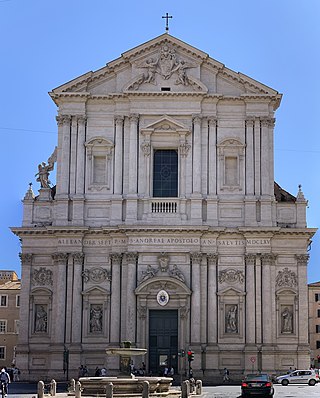
Sant'Andrea della Valle is a titular church and minor basilica in the rione of Sant'Eustachio of the city of Rome, Italy. The basilica is the seat of the general curia of the Theatines and is located on the Piazza Vidoni, at the intersection of Corso Vittorio Emanuele and Corso Rinascimento. It is one of the great 17th century preaching churches built by Counter-Reformation orders in the Centro Storico.

The Basilica of San Petronio is a minor basilica and church of the Archdiocese of Bologna located in Bologna, Emilia Romagna, northern Italy. It dominates Piazza Maggiore. The basilica is dedicated to the patron saint of the city, Saint Petronius, who was the bishop of Bologna in the fifth century. Construction began in 1390 and its main facade has remained unfinished since. The building was transferred from the city to the diocese in 1929; the basilica was finally consecrated in 1954. It has been the seat of the relics of Bologna's patron saint only since 2000; until then they were preserved in the Santo Stefano church of Bologna.

The Parish Basilica of Santa Maria del Popolo is a titular church and a minor basilica in Rome run by the Augustinian order. It stands on the north side of Piazza del Popolo, one of the most famous squares in the city. The church is hemmed in between the Pincian Hill and Porta del Popolo, one of the gates in the Aurelian Wall as well as the starting point of Via Flaminia, the most important route from the north. Its location made the basilica the first church for the majority of travellers entering the city. The church contains works by several famous artists, such as Raphael, Gian Lorenzo Bernini, Caravaggio, Alessandro Algardi, Pinturicchio, Andrea Bregno, Guillaume de Marcillat and Donato Bramante.
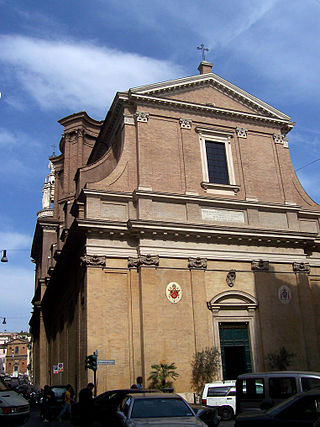
Sant'Andrea delle Fratte is a 17th-century basilica church in Rome, Italy, dedicated to St. Andrew. The Cardinal Priest of the Titulus S. Andreae Apostoli de Hortis is Ennio Antonelli.

The Basilica of Saint Mary of the Angels is a papal minor basilica situated in the plain at the foot of the hill of Assisi, Italy, in the frazione of Santa Maria degli Angeli.
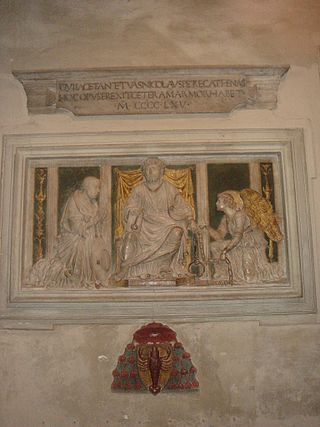
Andrea di Cristoforo Bregno (1418–1506) was an Italian Renaissance sculptor and architect of the Early Renaissance who worked in Rome from the 1460s and died just as the High Renaissance was getting under way.

The Basilica della Santissima Annunziata del Vastato is the Catholic cathedral of Genoa, northern Italy; its decoration employed the major baroque studios and artists in Genoa in the 17th century.

The Basilica of Saint Nicholas of Tolentino is a Roman Catholic church and minor basilica that is part of the Augustinian monastery in the hill-town of Tolentino, province of Macerata, Marche, central Italy. The church is a former cathedral of the Roman Catholic Diocese of Tolentino, suppressed in 1586.

San Marco is a church in Milan, northern Italy.

The Basilica of San Domenico, also known as Basilica Cateriniana, is a basilica church in Siena, Tuscany, Italy, one of the most important in the city. The basilica is an example of Cistercian Gothic style.

Santa Maria della Passione is a late Renaissance-style church located in Milan, Italy.

The Piccolomini Altarpiece is an architectural and sculptural altarpiece in the left-nave of Siena Cathedral, commissioned by cardinal Francesco Todeschini Piccolomini who expected it to become his tomb. However, he was elected Pope Pius III and buried in the Vatican. It was built between 1481 and 1485 by Andrea Bregno in Carrara marble, with additions in the following decades – these included four niche sculptures produced between 1501 and 1504 by Michelangelo of saints Peter, Augustine, Paul and Gregory. On top of the altar is the Madonna and Child, a sculpture (probably) by Jacopo della Quercia. The central painting of the Madonna is by Paolo di Giovanni Fei and from the late 14th century.

San Martino church, also called San Martino Maggiore is a Gothic-style, Roman Catholic church located at the corner of Via Marsala and Via Guglielmo Oberdan in Bologna, region of Emilia Romagna, Italy. The church was founded by the adjacent Carmelite monastery. On 10 August 1704 via the authority of the Vatican Chapter, the venerated image of the Virgin of Mount Carmel was crowned by Pope Clement XI. On 25 August 1941, Pope Pius XII elevated it to the status of basilica.
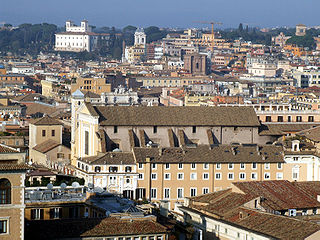
Santi Dodici Apostoli, commonly known as Santi Apostoli, is a 6th-century Catholic parish and titular church and minor basilica in Rome, Italy, the mother church of the Conventual Franciscan Order whose General Curia is in the adjacent building. Dedicated originally to St. James and St. Philip whose relics are kept here, and later to all Apostles, it is the Station church for Friday, the first week of Lent.

Santa Maria della Quercia is a Roman Catholic church located on the piazza of the same name, one block southeast of the Palazzo Farnese in the Rione (district) of Regola of central Rome, Italy.

The Basso Della Rovere or Saint Augustine Chapel is located in the south aisle of the basilica of Santa Maria del Popolo in Rome. This is the third side chapel from the counterfaçade and was dedicated to St. Augustine. The cycle of beautiful quattrocento frescoes was executed by Pinturicchio and his workshop.

The Sanctuary of Madonna dei Miracoli is a church in Alcamo, province of Trapani, Sicily, southern Italy; it is dedicated to the Madonna of the Miracles.

San Fortunato is a Gothic- and Renaissance-style, Roman Catholic church located on Piazza Umberto I #6 in the historic center of Todi, province of Perugia, region of Umbria, Italy.
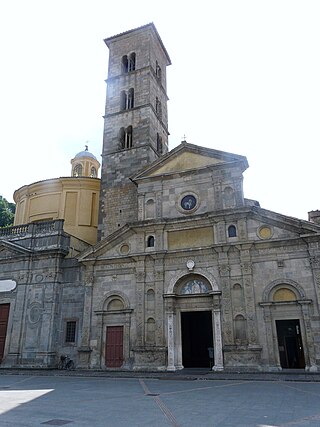
The Basilica of Santa Cristina is a Catholic basilica church in Bolsena, province of Viterbo, region of Lazio, Italy. The church is best known for being the site of a Eucharistic Miracle in 1263, immortalized by The Mass at Bolsena by Raphael in the Vatican palace. It also was the burial site for the martyr and saint Christina of Bolsena.

The Santuario di Maria Santissima della Fontenuova, or Sanctuary of the Holiest Mary of the New Fountain/Spring, is a Marian shrine (church) in piazza Giusti #305 in Monsummano Terme, Tuscany, Italy.